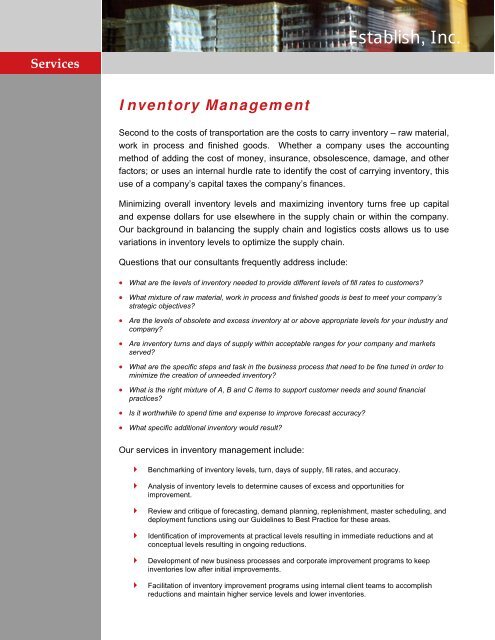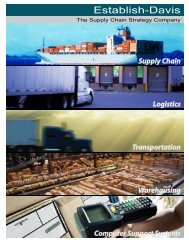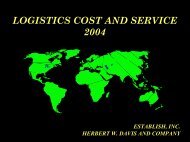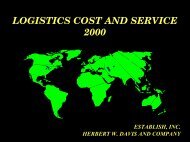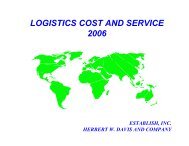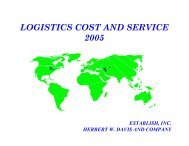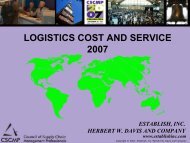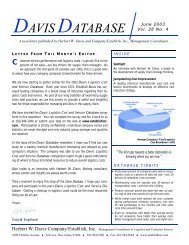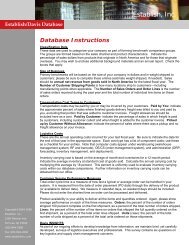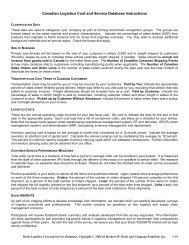Inventory Management - Supply Chain Consulting
Inventory Management - Supply Chain Consulting
Inventory Management - Supply Chain Consulting
You also want an ePaper? Increase the reach of your titles
YUMPU automatically turns print PDFs into web optimized ePapers that Google loves.
Services<br />
<strong>Inventory</strong> <strong>Management</strong><br />
Second to the costs of transportation are the costs to carry inventory – raw material,<br />
work in process and finished goods. Whether a company uses the accounting<br />
method of adding the cost of money, insurance, obsolescence, damage, and other<br />
factors; or uses an internal hurdle rate to identify the cost of carrying inventory, this<br />
use of a company’s capital taxes the company’s finances.<br />
Minimizing overall inventory levels and maximizing inventory turns free up capital<br />
and expense dollars for use elsewhere in the supply chain or within the company.<br />
Our background in balancing the supply chain and logistics costs allows us to use<br />
variations in inventory levels to optimize the supply chain.<br />
Questions that our consultants frequently address include:<br />
• What are the levels of inventory needed to provide different levels of fill rates to customers?<br />
• What mixture of raw material, work in process and finished goods is best to meet your company’s<br />
strategic objectives?<br />
• Are the levels of obsolete and excess inventory at or above appropriate levels for your industry and<br />
company?<br />
• Are inventory turns and days of supply within acceptable ranges for your company and markets<br />
served?<br />
• What are the specific steps and task in the business process that need to be fine tuned in order to<br />
minimize the creation of unneeded inventory?<br />
• What is the right mixture of A, B and C items to support customer needs and sound financial<br />
practices?<br />
• Is it worthwhile to spend time and expense to improve forecast accuracy?<br />
• What specific additional inventory would result?<br />
Our services in inventory management include:<br />
Benchmarking of inventory levels, turn, days of supply, fill rates, and accuracy.<br />
Analysis of inventory levels to determine causes of excess and opportunities for<br />
improvement.<br />
Establish, Inc.<br />
Review and critique of forecasting, demand planning, replenishment, master scheduling, and<br />
deployment functions using our Guidelines to Best Practice for these areas.<br />
Identification of improvements at practical levels resulting in immediate reductions and at<br />
conceptual levels resulting in ongoing reductions.<br />
Development of new business processes and corporate improvement programs to keep<br />
inventories low after initial improvements.<br />
Facilitation of inventory improvement programs using internal client teams to accomplish<br />
reductions and maintain higher service levels and lower inventories.
Case Study<br />
Establish, Inc.<br />
<strong>Inventory</strong> <strong>Management</strong>: Computer Peripheral Devices<br />
A manufacturer of computer peripheral devices was seeking to improve its balance sheet<br />
and P&L by reducing inventory and the associated carrying costs, while improving customer<br />
service. The markets and products were changing radically. The company needed to<br />
completely revamp its inventory, manufacturing and product support policies, procedures<br />
and practices to reflect basic changes in its product line from large, long lead-time,<br />
expensive long-lived engineered systems to relatively low-value, standalone, nearconsumer-product<br />
class units that support personal computers. Would it be possible to (1)<br />
take the profit hit resulting from disposing of obsolete inventory in order to get the balance<br />
sheet into shape and (2) institute a program to prevent the buildup of obsolete inventories<br />
by disposing of slow movers on a regular basis?<br />
Establish performed a logistics cost/performance benchmark showing that corporate<br />
logistics costs were almost 7 percent of sales. In all divisions, inventory carrying costs were<br />
extremely high. The bulk of the problem was in inventory management. There was an<br />
indication of product mix problems and the likelihood of large amounts of obsolete and slowmoving<br />
inventory.<br />
Establish performed a two-pronged attach on inventory. Like a SWAT team, we reduced<br />
E&O inventory using a team including Operations, Marketing, Sales, and Finance.<br />
Meanwhile, we also attacked the process that creates inventory.<br />
The comparison to best policies and practices indicated that there were issues in<br />
purchasing, materials management, inventory planning and management, and<br />
manufacturing operations. A set of recommendations for short-term inventory reduction and<br />
long-term business process and policy changes were prepared and presented.<br />
In purchasing and materials management, it was recommended that the total purchasing<br />
power of the corporation be leveraged to obtain more favorable purchasing and<br />
consignment agreements by centralizing the purchasing function. At the same time, local<br />
materials management functions would be strengthened to improve requisitioning and<br />
materials usage and upstream supply chain partnerships would be established to improve<br />
material flow and reduce purchased parts inventories.<br />
In inventory planning and management, a centralized logistics function was recommended.<br />
Logistics also developed written policies and procedures for inventory planning,<br />
management and reporting; implemented an integrated forecasting and inventory planning<br />
business process and information system; and resdesigned the forecasting and inventory<br />
planning process. All inventories are now managed more intensively to avoid excess and<br />
obsolete, and active inventories are now deployed and re-deployed based on the forecast<br />
requirements.<br />
The promotion process was brought under control to avoid sudden unanticipated demand<br />
on the plants and to move the slow-moving product. Manufacturing performance criteria<br />
was changed from lowest unit cost and high absorption to meeting the schedule in time and<br />
quantity to ensure proper inventory control and improved service levels.<br />
The company now recognizes the acceleration of change in its market, and the true nature<br />
of new markets and recognizes the impact of that change on inventory management policies<br />
and practices, and its potential impact on the financial fortunes of the company.


